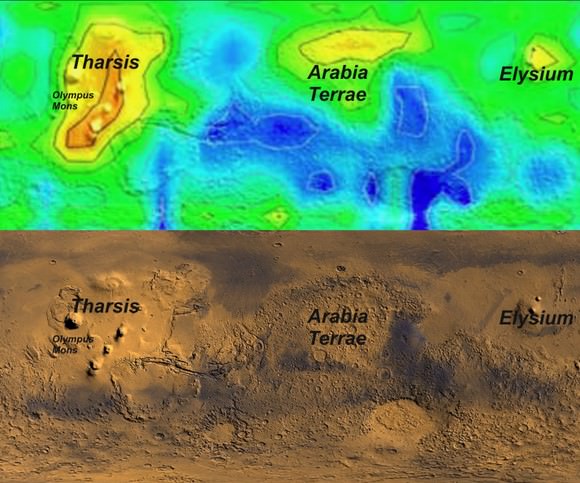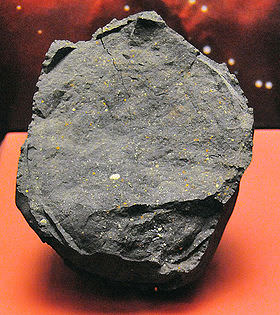[/caption]
Where does the methane on Mars come from? That has been one of the biggest unanswered questions in planetary science since the discovery of large plumes of methane gas in the Martian atmosphere. Scientists have been trying to figure out how the planet’s environment or geology can keep replenishing this short-lived gas, and of course, in the back of everyone’s mind is whether the methane has any connection to possible life on Mars.
A new potential explanation squelches both the life and environment prospect and offers a unique answer. A group of researchers found that meteorites, which continually bombard the surface of Mars, may contain enough carbon compounds to generate methane when they are exposed to strong UV sunlight.
“Whether or not Mars is able to sustain life is not yet known, but future studies should take into account the role of sunlight and debris from meteorites in shaping the planet’s atmosphere,” said Dr. Andrew McLeod, of the University of Edinburgh, co-author of a new study published in Nature this week.
The group of European researchers looked at the famous Murchison meteorite, a carbonaceous chondrite meteorites that fell in Australia more than 40 years ago. Carbonaceous chondrites are very common meteorites, so they likely will be falling on Mars. The team exposed particles of the Murchison meteorite to levels of ultraviolet radiation equivalent to sunlight on Mars.
When the meteorite pieces were exposed to ample amounts of UV light the meteor fragments rapidly released methane. After the UV exposure was reduced, the amount of methane produced would lessen, but if there were other activities, such as heating, shaking or lowering the pressure on the meteorite, the amount of methane released would rise again.
With Mars thin atmosphere, UV light easily gets to the surface of the planet. The thin atmosphere also allows more meteorites to hit Mars than on Earth (estimates range from just a few thousands of metric tons to as much as 60,000 metric tons.) The team said that temperature changes on Mars, especially during the summertime when it gets warm, could account for a boost of methane release from meteorites, and seasonal dust storms could shake or move the meteorites.
However, while only small amounts of methane are present in the Martian atmosphere, it seems to be coming from very specific, localized sources. Meteorites would likely be falling across the planet.

Additionally, levels of methane vary in the seasons, and are highest in autumn in the northern hemisphere, with localized peaks of 70 parts per billion. There is a sharp decrease in winter, with only a faint band of methane appearing in the atmosphere between 40-50 degrees north.
Methane was first detected in the Martian atmosphere by ground based telescopes in 2003 and confirmed a year later by ESA’s Mars Express spacecraft. In 2009, observations using ground based telescopes showed the first evidence of a seasonal cycle.
Other research has said that the methane in the Martian atmosphere lasts less than a year, making it a flitting – and difficult – feature to study.
Another issue is that the estimates for the amount of meteorites hitting Mars’ surface would likely not bring enough carbon to explain the amount of methane seen in the atmosphere.
The researchers said, however, that their findings give valuable insights into the planet’s atmosphere and these findings would be helpful for future robotic missions to Mars so scientists could fine-tune their experiments, potentially making their trips more valuable.


I wonder how many years it’ll be before we have a conclusive answer to the riddle of the Mars methane cycle.
Would be nice to think the Curiosity rover will help gather more info and evidence to help resolve this interesting mystery.
How is the methane concentration plotted?
I am guessing the plot shows the methane in parts per billion of the atmosphere. Olympus Mons has an atmospheric pressure that is only 5% of the martian average. If meteorites were scattered at random over Mars, and the methane stayed roughly where it was released, then we would get 20x the concentration at Olympus Mons just because there is less other atmosphere to dilute it.
Mars has winds, and methane is continuously removed from the atmosphere. I don’t know what a detailed simulation would predict, but a 3x methane concentration peak above the high bits would seem in the right sort of order of things.
“Whether or not Mars is able to sustain life is not yet known…” Excuse me? http://www.dlr.de/dlr/en/desktopdefault.aspx/tabid-10081/151_read-3409/
The linked research shows that even puny Earth-life is able to survive on Mars so imagine Martian life (Viking LR ?) which would have had plenty of time to adapt to the harsh conditions there?
Mars Farts? So that’s how E.R.B. came up with “Barsoom”! It was onomatopoeic. 🙂
I’m guessing the methane on mars had to be their for thousands upon thousands of years and why or how could their be methane on mars??
shows the importance of Martian meteorites in our institutions and collections.Scientists all over the world continue to do important research on this fascinating subject
shows the importance of Martian meteorites in our institutions and collections.Scientists all over the world continue to do important research on this fascinating subject